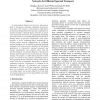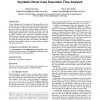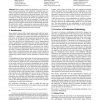168 search results - page 5 / 34 » Modeling Assembly Instruction Timing in Superscalar Architec... |
ISHPC
1999
Springer
13 years 11 months ago
1999
Springer
Superscalar microprocessor efficiency is generally not as high as anticipated. In fact, sustained utilization below thirty percent of peak is not uncommon, even for fully optimized...
IPPS
2005
IEEE
14 years 21 days ago
2005
IEEE
As semiconductor feature sizes decrease, interconnect delay is becoming a dominant component of processor cycle times. This creates a critical need to shift microarchitectural des...
INFOVIS
1999
IEEE
13 years 11 months ago
1999
IEEE
The advent of superscalar processors with out-of-order execution makes it increasingly difficult to determine how well an application is utilizing the processor and how to adapt t...
DAC
2004
ACM
14 years 8 months ago
2004
ACM
ion of Assembler Programs for Symbolic Worst Case Execution Time Analysis Tobias Schuele Tobias.Schuele@informatik.uni-kl.de Klaus Schneider Klaus.Schneider@informatik.uni-kl.de Re...
DAC
1997
ACM
13 years 10 months ago
1997
ACM
Abstract. Many modern systems are designed as a set of interconnected reactive subsystems. The subsystem verification task is to verify an implementation of the subsystem against t...



